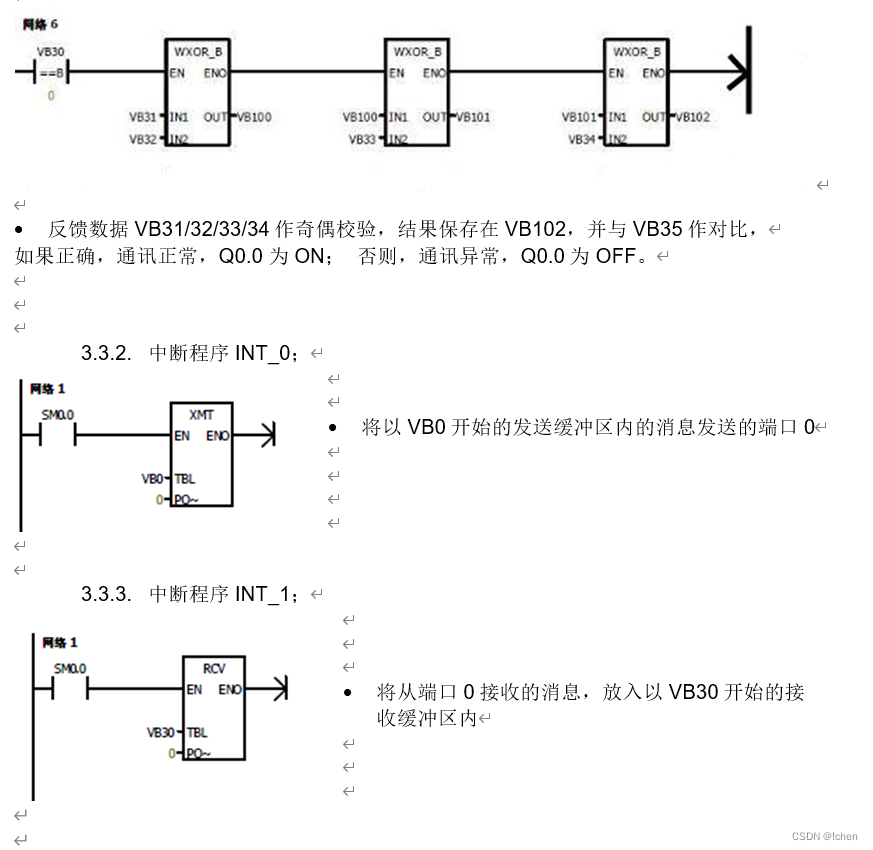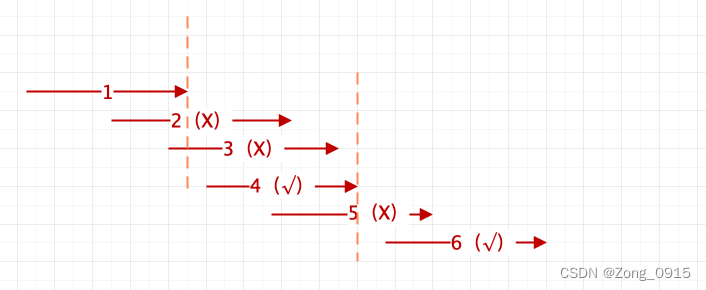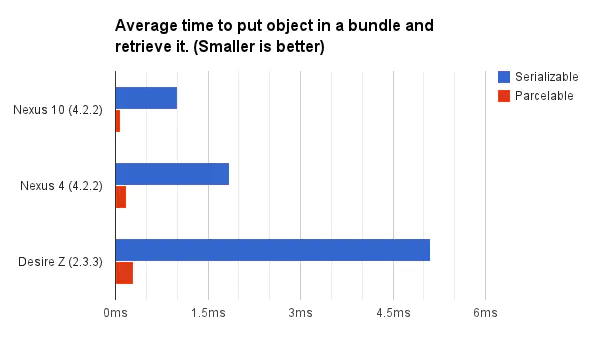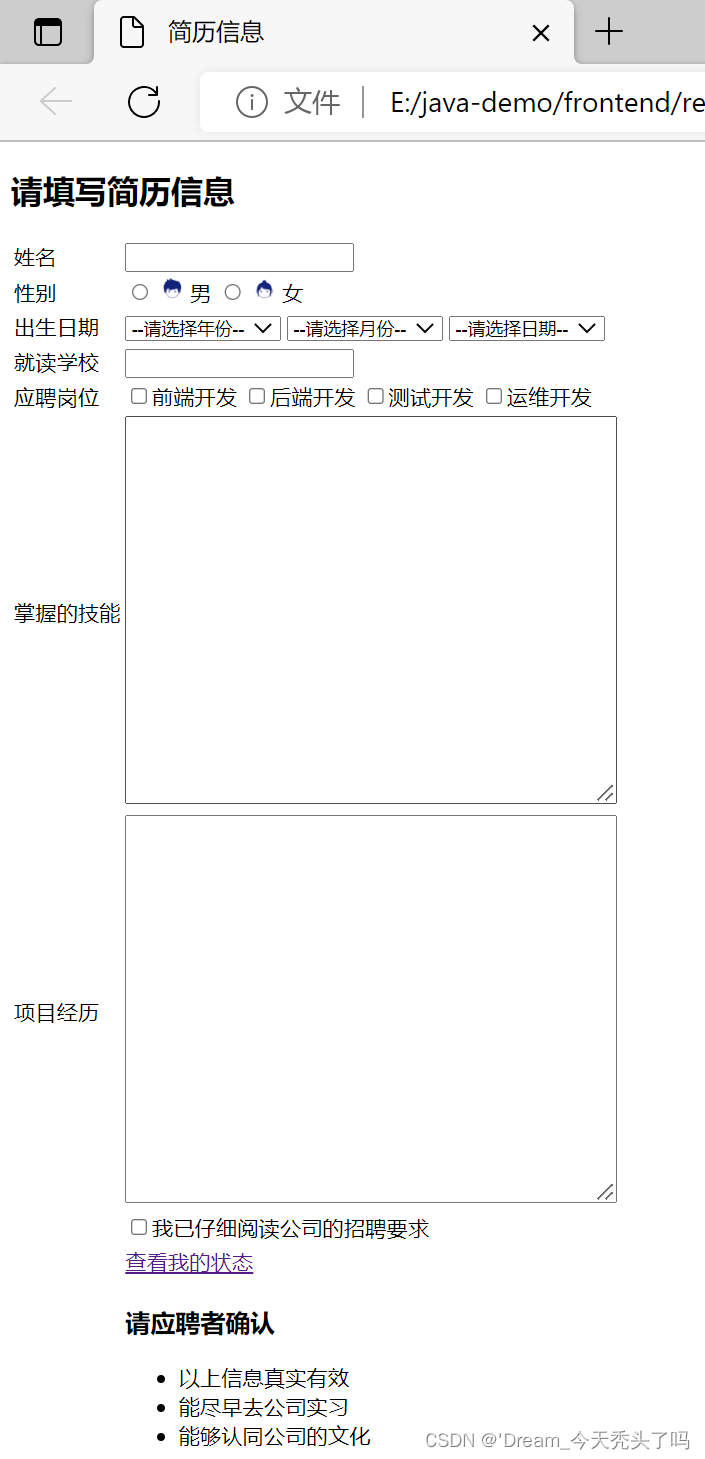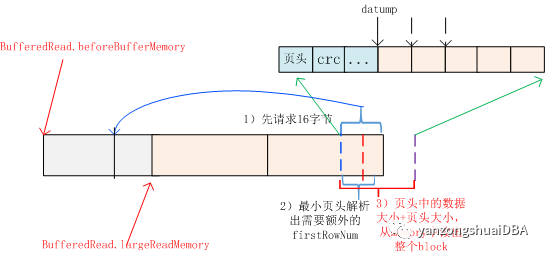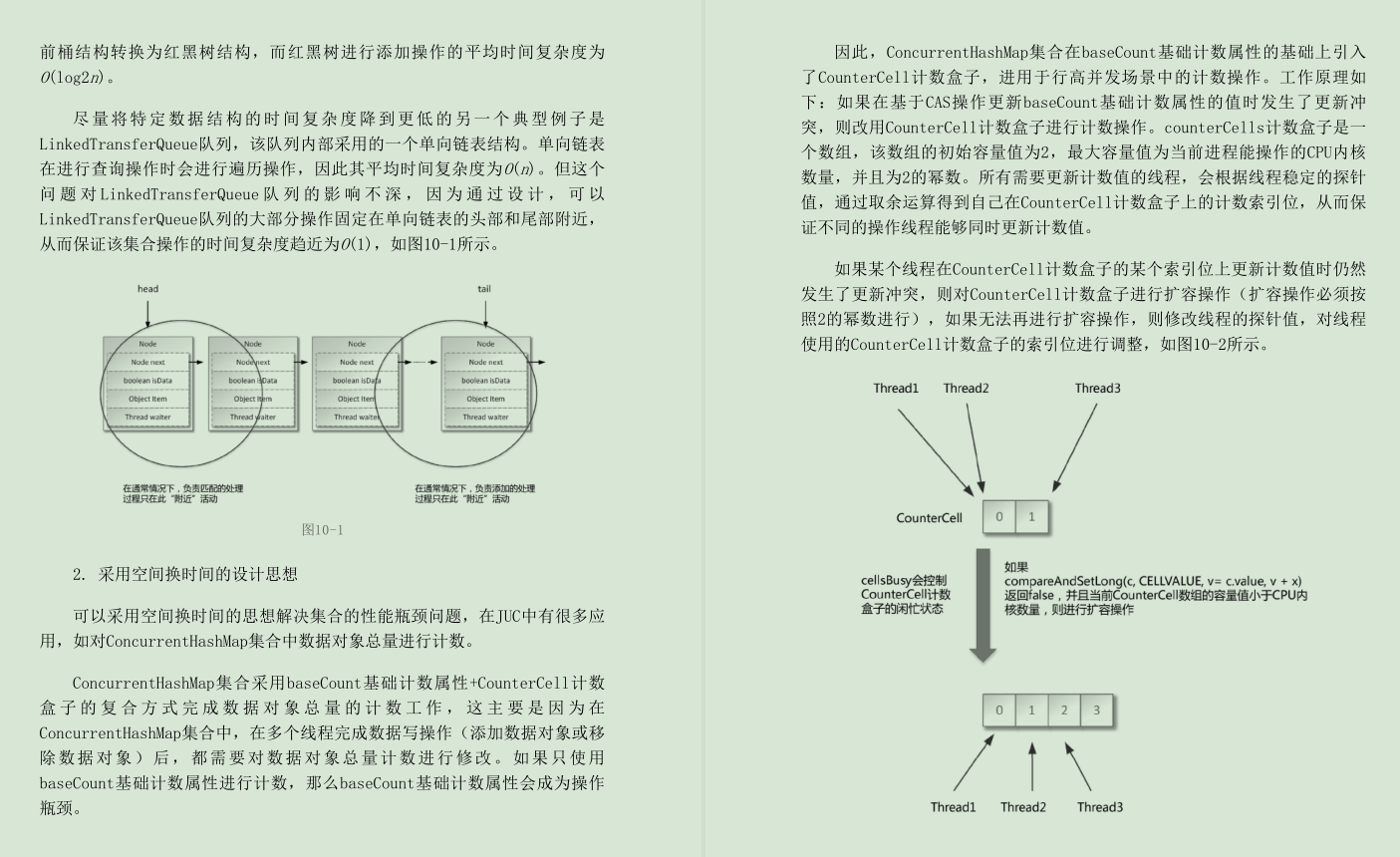目录
1.链表
2.链表的模拟实现
3.LinkedList的模拟实现
4.LinkedList的使用
4.1 什么是LinkedList
4.2 LinkedList的使用
5.ArrayList和LinkedList的区别
我的GitHub:Powerveil · GitHub
我的Gitee:Powercs12 (powercs12) - Gitee.com
皮卡丘每天学Java
1.链表
链表也是线性表的一种。
链表是一种物理存储结构上非连续存储结构,数据元素的逻辑顺序是通过链表中的引用链接次序实现的 。

注意:
从上图可以看出,链式结构在逻辑上是连续的,但是在物理上不一定连续
现实中的结点一般都是从堆上申请出来
从堆上申请的空间,是按照一定的策略来分配的,两次申请的空间可能连续,也可能不连续
实际中链表的结构非常多样,以下情况组合起来就有8种链表结构:
1. 单向或者双向

2. 带头或者不带头

3. 循环或者非循环
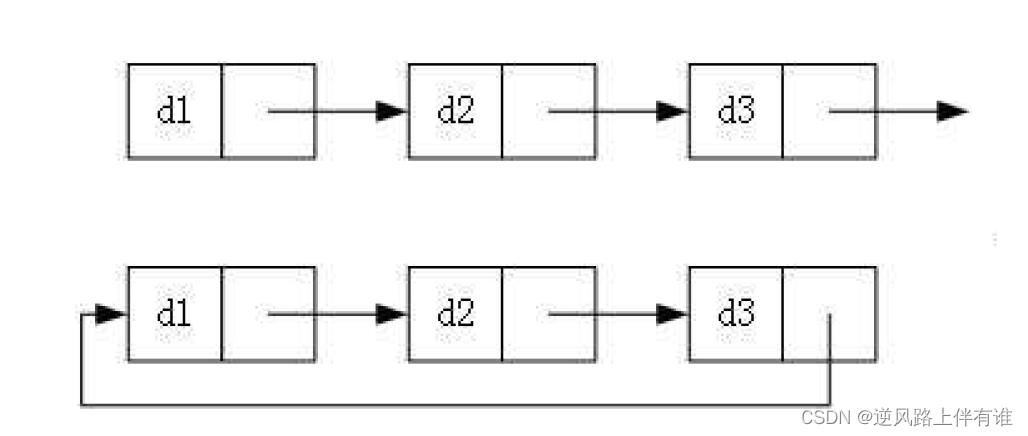
虽然有这么多的链表的结构,但是我们重点掌握两种:
- 无头单向非循环链表:结构简单,一般不会单独用来存数据。实际中更多是作为其他数据结构的子结构,如哈希桶、图的邻接表等等。另外这种结构在笔试面试中出现很多。
- 无头双向链表:在Java的集合框架库中LinkedList底层实现就是无头双向循环链表。

2.链表的模拟实现
public class MyLinkedList {
public ListNode head;
static class ListNode {
public int val;
public ListNode next;
public ListNode(int val) {
this.val = val;
}
}
/**
* 通过穷举的方式 创建一个链表出来
* 现在这样做 只是为了能够让初学者对这个结构更好的了解
* 后期 我会改回来。
*/
public void createList() {
ListNode node1 = new ListNode(10);
ListNode node2 = new ListNode(12);
ListNode node3 = new ListNode(23);
ListNode node4 = new ListNode(34);
node1.next = node2;
node2.next = node3;
node3.next = node4;
head = node1;
}
public void display() {
ListNode cur = head;
while (cur != null) {
System.out.printf(cur.val + " ");
cur = cur.next;
}
System.out.println();
}
public void display(ListNode node) {
ListNode cur = node;
while (cur != null) {
System.out.printf(cur.val + " ");
cur = cur.next;
}
System.out.println();
}
//查找是否包含关键字key是否在单链表中
public boolean contains(int key) {
ListNode cur = head;
while (cur != null) {
if (cur.val == key) return true;
cur = cur.next;
}
return false;
}
//得到单链表的长度
public int size() {
ListNode cur = head;
int count = 0;
while (cur != null) {
count++;
cur = cur.next;
}
return count;
}
//头插法:O(1)
public void addFirst(int data) {
ListNode node = new ListNode(data);
node.next = head;
head = node;
}
//尾插法:O(n)
public void addLast(int data) {
ListNode node = new ListNode(data);
if (head == null) {
head = node;
} else {
ListNode cur = head;
while (cur.next != null) {
cur = cur.next;
}
cur.next = node;
}
}
private void checkIndex(int index) {
if (index < 0 || index > size()) {
throw new IndexNotLegalException("index的值不合法");
}
}
//任意位置插入,第一个数据节点0号下标
public void addIndex(int index, int data) {
checkIndex(index);
//下标为0是头插
if (index == 0) {
addFirst(data);
}
//下标为size是尾插
if (index == size()) {
addLast(data);
}
//中间插
ListNode node = new ListNode(data);
ListNode cur = findIndex(index - 1);
node.next = cur.next;
cur.next = node;
}
//找到指定下标节点
public ListNode findIndex(int index) {
ListNode cur = head;
while (index > 0) {
cur = cur.next;
index--;
}
return cur;
}
//删除第一次出现关键字为key的节点
public void remove(int key) {
// if (head == null) {
// throw new RuntimeException("链表没有元素不可以删除");
// }
if (head.val == key) {
head = head.next;
return;
}
ListNode cur = searchPrevOfKey(key);
if (cur == null) return;
ListNode del = cur.next;
cur.next = del.next;
// cur.next = cur.next.next;
}
//根据值找到前一个节点
private ListNode searchPrevOfKey(int key) {
if (head == null) return null;
ListNode cur = head;
while (cur.next != null) {
if (cur.next.val == key) return cur;
cur = cur.next;
}
return null;
}
//删除所有值为key的节点
public void removeAllKey(int key) {
if (head == null) return;
ListNode cur = head;
while (cur.next != null) {
ListNode curNext = cur.next;
if (curNext.val == key) {
cur.next = curNext.next;
} else {
cur = curNext;
}
}
if (head.val == key) {
head = head.next;
}
}
//清空链表
public void clear() {
ListNode cur = head;
while (cur != null) {
ListNode curNext = cur.next;
cur.next = null;
cur = curNext;
}
head = null;
}
}3.LinkedList的模拟实现
public class MyLinkedList {
// 头节点
public ListNode head;
// 节点
static class ListNode {
public int val;
public ListNode next;
public ListNode(int val) {
this.val = val;
}
}
// 打印链表
public void display() {
ListNode cur = head;
while (cur != null) {
System.out.printf(cur.val + " ");
cur = cur.next;
}
System.out.println();
}
// 从某个节点开始打印
public void display(ListNode node) {
ListNode cur = node;
while (cur != null) {
System.out.printf(cur.val + " ");
cur = cur.next;
}
System.out.println();
}
// 查找是否包含关键字key是否在单链表中
public boolean contains(int key) {
ListNode cur = head;
while (cur != null) {
if (cur.val == key) return true;
cur = cur.next;
}
return false;
}
// 得到单链表的长度
public int size() {
ListNode cur = head;
int count = 0;
while (cur != null) {
count++;
cur = cur.next;
}
return count;
}
// 头插法:O(1)
public void addFirst(int data) {
ListNode node = new ListNode(data);
node.next = head;
head = node;
}
// 尾插法:O(n)
public void addLast(int data) {
ListNode node = new ListNode(data);
if (head == null) {
head = node;
} else {
ListNode cur = head;
while (cur.next != null) {
cur = cur.next;
}
cur.next = node;
}
}
// 检查下标是否合法
private void checkIndex(int index) {
if (index < 0 || index > size()) {
throw new IndexNotLegalException("index的值不合法");
}
}
// 任意位置插入,第一个数据节点0号下标
public void addIndex(int index, int data) {
checkIndex(index);
// 下标为0是头插
if (index == 0) {
addFirst(data);
}
// 标为size是尾插
if (index == size()) {
addLast(data);
}
// 中间插
ListNode node = new ListNode(data);
ListNode cur = findIndex(index - 1);
node.next = cur.next;
cur.next = node;
}
// 找到指定下标节点
public ListNode findIndex(int index) {
ListNode cur = head;
while (index > 0) {
cur = cur.next;
index--;
}
return cur;
}
// 删除第一次出现关键字为key的节点
public void remove(int key) {
// if (head == null) {
// throw new RuntimeException("链表没有元素不可以删除");
// }
if (head.val == key) {
head = head.next;
return;
}
ListNode cur = searchPrevOfKey(key);
if (cur == null) return;
ListNode del = cur.next;
cur.next = del.next;
// cur.next = cur.next.next;
}
// 根据值找到前一个节点
private ListNode searchPrevOfKey(int key) {
if (head == null) return null;
ListNode cur = head;
while (cur.next != null) {
if (cur.next.val == key) return cur;
cur = cur.next;
}
return null;
}
// 删除所有值为key的节点
public void removeAllKey(int key) {
if (head == null) return;
ListNode cur = head;
while (cur.next != null) {
ListNode curNext = cur.next;
if (curNext.val == key) {
cur.next = curNext.next;
} else {
cur = curNext;
}
}
if (head.val == key) {
head = head.next;
}
}
// 清空链表
public void clear() {
ListNode cur = head;
while (cur != null) {
ListNode curNext = cur.next;
cur.next = null;
cur = curNext;
}
head = null;
}
}4.LinkedList的使用
4.1 什么是LinkedList
官方文档
LinkedList (Java Platform SE 8 )
LinkedList的底层是双向链表结构,由于链表没有将元素存储在连续的空间中,元素存储在单独的节点中,然后通过引用将节点连接起来了,因此在在任意位置插入或者删除元素时,不需要搬移元素,效率比较高。

下面是类图
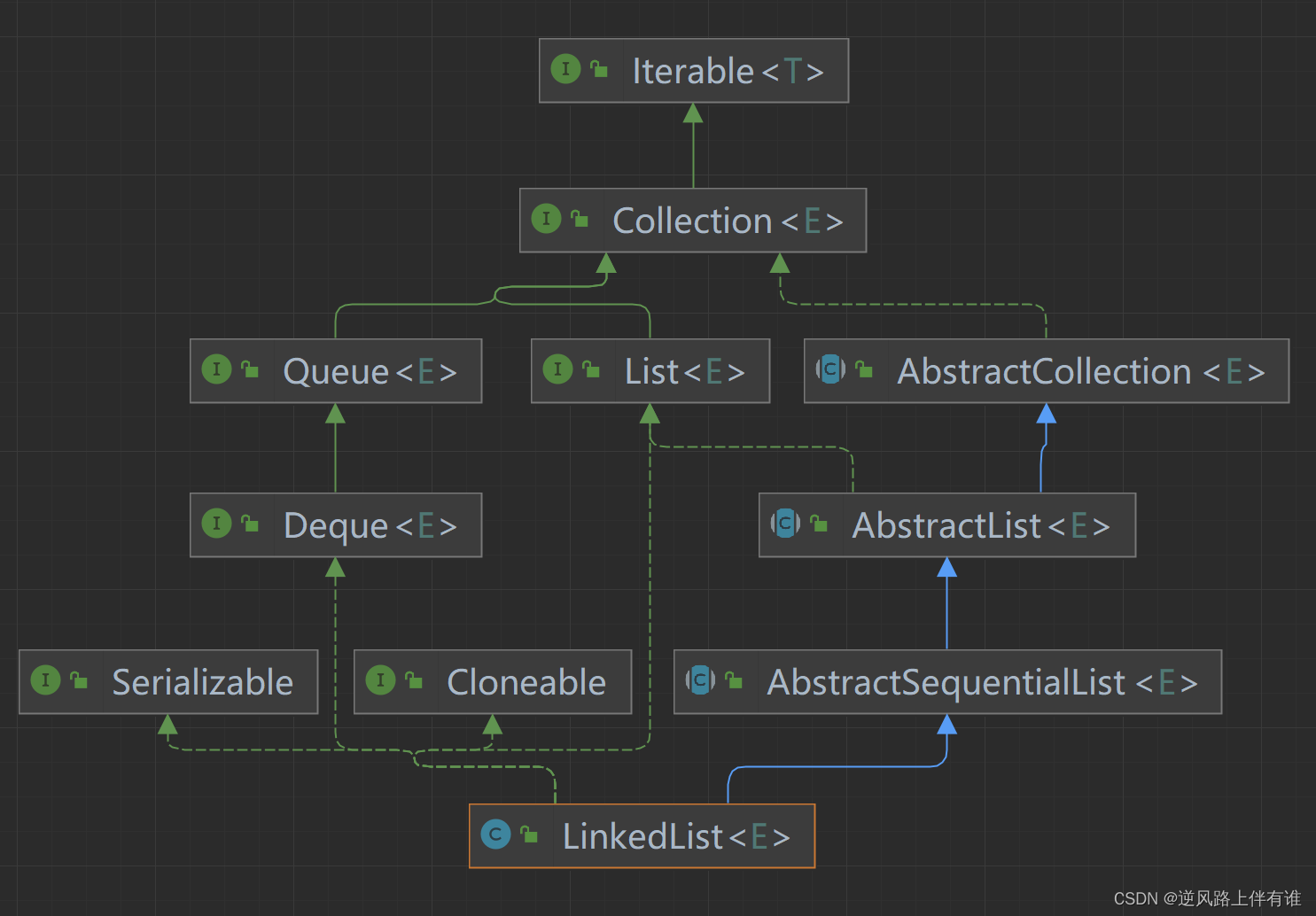
1. LinkedList实现了List接口
2. LinkedList的底层使用了双向链表
3. LinkedList没有实现RandomAccess接口,因此LinkedList不支持随机访问
注意:插入和删除的时间复杂度都为O(n),因为找到节点需要遍历。
4.2 LinkedList的使用
LinkedList的构造
| 方法 | 解释 |
|---|---|
| LinkedList() | 无参构造 |
| public LinkedList(Collection<? extends E> c) | 使用其他集合容器中元素构造List |
@SuppressWarnings({"all"})
public class Test {
public static void main(String[] args) {
// 构造一个空的LinkedList
LinkedList<String> linkedList1 = new LinkedList<>();
List<String> list = new ArrayList<>();
list.add("Hello world!");
list.add("每天学Java");
list.add("逐渐提升");
list.add("...");
// 使用ArrayList构造LinkedList
LinkedList<String> linkedList2 = new LinkedList<>(list);
}
}LinkedList的其他常用方法介绍
| 方法 | 解释 |
|---|---|
| boolean add(E e) | 尾插 e |
| void add(int index, E element) | 将 e 插入到 index 位置 |
| boolean addAll(Collection<? extends E> c) | 尾插 c 中的元素 |
| E remove(int index) | 删除 index 位置元素 |
| boolean remove(Object o) | 删除遇到的第一个 o |
| E get(int index) | 获取下标 index 位置元素 |
| E set(int index, E element) | 将下标 index 位置元素设置为 element |
| void clear() | 清空 |
| boolean contains(Object o) | 判断 o 是否在线性表中 |
| int indexOf(Object o) | 返回第一个 o 所在下标 |
| int lastIndexOf(Object o) | 返回最后一个 o 的下标 |
| List<E> subList(int fromIndex, int toIndex) | 截取部分 list |
public static void main(String[] args) {
LinkedList<Integer> list = new LinkedList<>();
list.add(1); // add(elem): 表示尾插
list.add(2);
list.add(3);
list.add(4);
list.add(5);
list.add(6);
list.add(7);
System.out.println(list.size());
System.out.println(list);
// 在起始位置插入0
list.add(0, 0); // add(index, elem): 在index位置插入元素elem
System.out.println(list);
list.remove(); // remove(): 删除第一个元素,内部调用的是removeFirst()
list.removeFirst(); // removeFirst(): 删除第一个元素
list.removeLast(); // removeLast(): 删除最后元素
list.remove(1); // remove(index): 删除index位置的元素
System.out.println(list);
// contains(elem): 检测elem元素是否存在,如果存在返回true,否则返回false
if (!list.contains(1)) {
list.add(0, 1);
}
list.add(1);
System.out.println(list);
System.out.println(list.indexOf(1)); // indexOf(elem): 从前往后找到第一个elem的位置
System.out.println(list.lastIndexOf(1)); // lastIndexOf(elem): 从后往前找第一个1的位置
int elem = list.get(0); // get(index): 获取指定位置元素
list.set(0, 100); // set(index, elem): 将index位置的元素设置为elem
System.out.println(list);
// subList(from, to): 用list中[from, to)之间的元素构造一个新的LinkedList返回
List<Integer> copy = list.subList(0, 3);
System.out.println(list);
System.out.println(copy);
list.clear(); // 将list中元素清空
System.out.println(list.size());
}LinkedList的遍历
public static void main(String[] args) {
LinkedList<Integer> list = new LinkedList<>();
list.add(1); // add(elem): 表示尾插
list.add(2);
list.add(3);
list.add(4);
list.add(5);
list.add(6);
list.add(7);
System.out.println(list.size());
// foreach遍历
for (int e:list) {
System.out.print(e + " ");
}
System.out.println();
// 使用迭代器遍历---正向遍历
ListIterator<Integer> it = list.listIterator();
while(it.hasNext()){
System.out.print(it.next()+ " ");
}
System.out.println();
// 使用反向迭代器---反向遍历
ListIterator<Integer> rit = list.listIterator(list.size());
while (rit.hasPrevious()){
System.out.print(rit.previous() +" ");
}
System.out.println();
}5.ArrayList和LinkedList的区别
| 不同点 | ArrayList | LinkedList |
|---|---|---|
| 存储空间上 | 物理上一定连续 | 逻辑上连接,但物理上不一定连接 |
| 随机访问 | 支持O(1) | 不支持:O(N) |
| 头插 | 需要搬移元素,效率低O(N) | 只需修改引用的指向,时间复杂度为O(1) |
| 插入 | 空间不够时需要扩容 | 没有容量的概念 |
| 应用场景 | 元素搞笑存储+频繁访问 | 任意位置插入和删除频繁 |

